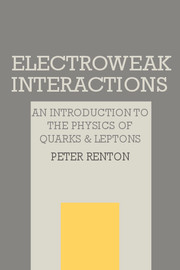Book contents
- Frontmatter
- Contents
- Preface
- 1 Introduction
- 2 Towards a quantum field theory
- 3 Wave equations, propagators and fields
- 4 Quantum electrodynamics
- 5 From Fermi theory to the standard model
- 6 Purely leptonic interactions
- 7 Deep inelastic scattering and quantum chromodynamics
- 8 Weak hadronic currents, electroweak interference effects
- 9 Quark and lepton oscillations
- 10 The standard model and beyond
- Appendix A Units
- Appendix B Properties of γ-matrices
- Appendix C Cross-sections, decay rates and Feynman rules
- Appendix D Dirac δ-function
- Appendix E Fierz transformation
- Appendix F Creation and annihilation operators for a Dirac field
- References
- Index
- Frontmatter
- Contents
- Preface
- 1 Introduction
- 2 Towards a quantum field theory
- 3 Wave equations, propagators and fields
- 4 Quantum electrodynamics
- 5 From Fermi theory to the standard model
- 6 Purely leptonic interactions
- 7 Deep inelastic scattering and quantum chromodynamics
- 8 Weak hadronic currents, electroweak interference effects
- 9 Quark and lepton oscillations
- 10 The standard model and beyond
- Appendix A Units
- Appendix B Properties of γ-matrices
- Appendix C Cross-sections, decay rates and Feynman rules
- Appendix D Dirac δ-function
- Appendix E Fierz transformation
- Appendix F Creation and annihilation operators for a Dirac field
- References
- Index
Summary
STRONG, ELECTROMAGNETIC AND WEAK INTERACTIONS
One of the main objectives of physics is to find out what, if any, are the basic constituents of matter and to understand the nature of the forces by which they interact. Fundamental particles appear, at present, to be of two distinct types. The first group consists of quarks and leptons. These are spin ½ particles obeying Fermi–Dirac statistics (fermions). The second group consists of the so-called gauge bosons. These are integral spin particles obeying Bose–Einstein statistics (bosons). The gauge bosons appear to be responsible for mediating the interaction forces between quarks and leptons. Existing results show clear evidence for four types of interactions in nature. These are the strong, electromagnetic, weak and gravitational interactions. Our knowledge of these interactions stems, to a great extent, from our understanding of the underlying symmetries which appear to exist in nature and in the way in which they appear to be broken.
The world is made up of ninety-two naturally occurring chemical elements. The properties of a given isotope of an element do not, as far as we know, depend on its origin. These elements are composed of electrons and nuclei, which are in turn composed of protons and neutrons. The electrons are fermions and obey the Pauli exclusion principle. This leads to an elaborate shell structure and important differences in the chemical properties of the elements. Prior to the development of particle accelerators, studies in particle physics were limited to indirect means.
- Type
- Chapter
- Information
- Electroweak InteractionsAn Introduction to the Physics of Quarks and Leptons, pp. 1 - 40Publisher: Cambridge University PressPrint publication year: 1990

